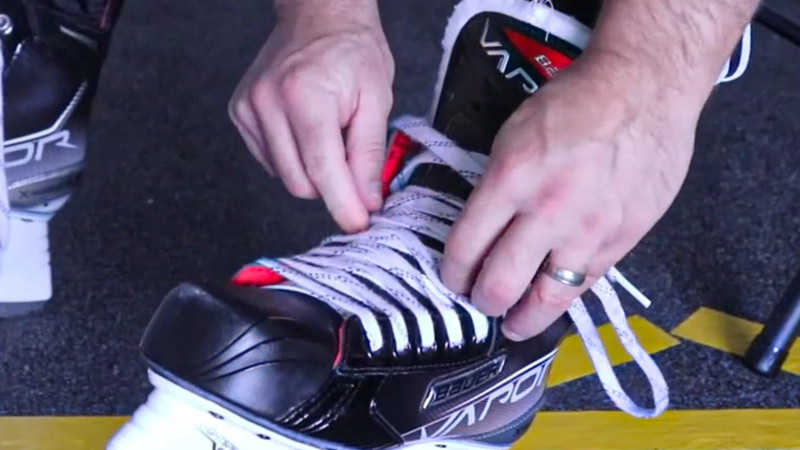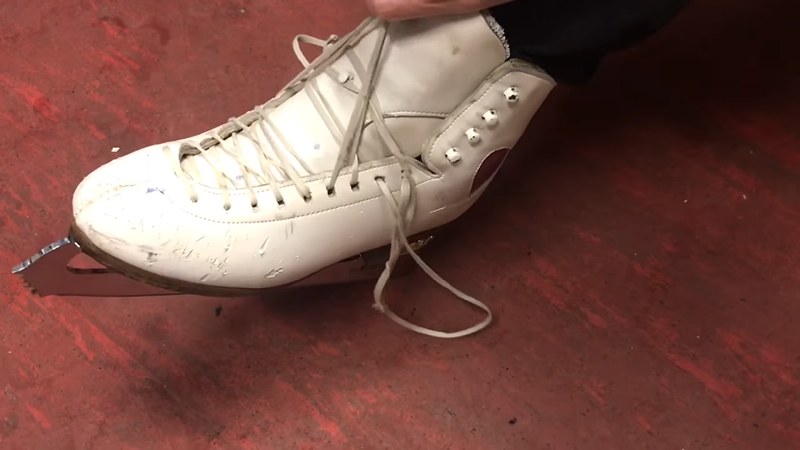Tying your skates may seem like a simple task, but for anyone who’s spent time gliding across the ice or maneuvering through the rink, it’s evident that this seemingly mundane process plays a pivotal role in your skating experience.
Whether you’re a hockey player, figure skater, or just someone who enjoys the thrill of skating, knowing how to tie your skates correctly is essential. In this comprehensive guide, we’ll delve into the nuances of skatetying.
From lacing techniques that provide maximum support and comfort to strategies for preventing common issues like lace bite and heel slippage, we’ve got you covered. Then we will deal with tips and tricks to help you fine-tune your lacing game and elevate your skating performance. Stay focused.
Is Tying Hockey Skates Difficult?
Tying hockey skates may seem daunting at first, but with practice, it becomes a straightforward process. The key is achieving a snug and secure fit to ensure comfort and optimal performance on the ice.
Start by loosening the laces completely and slide your foot into the skate. Begin lacing from the bottom, making sure the tension is even on both sides. Cross the laces over each other as you work your way up, pulling them tight but not too tight to avoid cutting off circulation.
Once you reach the top, tie a secure knot or use a lace lock to prevent them from coming undone. While it might take a few tries to get the tension just right, it’s a skill that most hockey players quickly master.
With practice, you’ll be able to tie your hockey skates efficiently, ensuring a comfortable and secure fit for every game or practice session.
Different Types of Laces of Hockey Skates
Hockey skate laces come in various types, each designed to cater to different preferences and needs. Here are some common types of hockey skate laces:
Waxed Laces
Waxed laces have a coating that provides added friction, making it easier to grip and tighten the laces. This helps them stay in place during gameplay and prevents them from coming undone.
Unwaxed Laces
Unwaxed laces are plain and lack the wax coating. They are easier to slide through the eyelets but may require more frequent retying as they tend to loosen during play.
Flat Laces
Flat laces have a wider profile, offering increased surface area for more even pressure distribution across the skate’s tongue. This can enhance comfort and reduce pressure points.
Round Laces
Round laces are thinner and round in shape. They are less bulky than flat laces and can be easier to tighten, but some players prefer the added comfort provided by flat laces.
Bauer Tuuk LS Pulse Laces
These laces feature a textured design on the waxed surface, which enhances grip and helps maintain tension throughout a game.
Colored Laces
These laces come in various colors and are often used to add a touch of style or match team uniforms.
Kevlar Laces
Kevlar-reinforced laces are exceptionally durable and resistant to wear and tear, making them a popular choice for players seeking longevity.
Bungee Laces
Bungee laces incorporate an elastic section that allows for quick and easy tightening, eliminating the need for traditional tying. They are popular among young players and those looking to save time getting on the ice.
The choice of hockey skate laces often boils down to personal preference, with factors like ease of tightening, durability, and style influencing the decision.
Choosing the Right Lacing Technique

Selecting the right lacing technique for your hockey skates can significantly impact your comfort, performance, and injury prevention. Here are some common lacing techniques and their purposes:
Standard Crisscross Lacing
This is the most basic and common lacing technique. It provides a balanced fit and even pressure distribution. It’s suitable for most players and works well for beginners.
Tight Heel Lock
To prevent heel slippage, create additional loops around the ankle area by lacing through the same eyelets multiple times. This technique enhances stability but may reduce ankle mobility slightly.
Wide Forefoot Lacing
If you have wide feet or need extra room in the toe box, skip some eyelets near the forefoot area to create a wider opening. This reduces pressure on the sides of the foot.
Narrow Forefoot Lacing
Conversely, if you have narrow feet, lacing through all eyelets tightly near the forefoot can provide a snug fit and reduce excess movement within the skate.
Skipping Eyelets
Players with specific fit issues can skip certain eyelets to alleviate pressure points or accommodate unique foot shapes. Experiment with different skip patterns to find the most comfortable fit.
Double Knot
After tying your skates, consider double-knotting the laces or using lace locks to prevent them from coming undone during play.
Toe Cap Lacing
Some players prefer to skip the very top eyelet and lace their skates across the toe cap, creating a unique fit that allows for more forward flexion. This can be helpful for players who need greater agility.
Lacing Around the Back
For added heel stability, lace around the back of the skate before proceeding with the crisscross lacing pattern. This helps secure the heel firmly in place.
How To Tie A Hockey Skate Tight?
Tying your hockey skates tightly is essential for proper support, performance, and injury prevention. Here’s a step-by-step guide on how to tie your hockey skates tightly:
Loosen the Laces
Start with all the laces completely loosened to ensure that your foot can easily slide into the skate.
Insert Your Foot
Place your foot into the skate, ensuring your heel is snugly against the back of the boot. Your toes should lightly touch the front, leaving a slight amount of space for comfort.
Begin Lacing
Begin lacing your skates from the bottom eyelets, pulling the laces through, and making sure they are even on both sides.
Crisscross Lacing
Cross the laces over each other, moving from the bottom up. As you cross them, pull them tight to maintain even tension.
Alternate Sides
Continue crisscrossing the laces while alternating sides, pulling each lace tight with each crossover. This ensures a secure and balanced fit.
Tighten the Ankles
When you reach the eyelets around the ankle area, pay extra attention to tightening the laces. This is crucial for ankle support and stability.
Locking the Heel
Once you reach the top eyelets, create a “lock” by feeding each lace under the opposite side (left lace under the right, and right lace under the left) through the top eyelets. Pull them tightly to secure the lock.
Tie a Knot
Tie a secure knot at the top to prevent the laces from coming undone. You can use a double knot or a lace lock, which is a device designed to keep laces in place.
Check for Comfort and Support
After lacing up, stand up and check for comfort and support. Your foot should feel snugly secured in the skate, with minimal movement inside. There should be no pressure points or discomfort.
Repeat for the Other Skate
Repeat the same lacing process for your other skate.
Remember that finding the perfect tightness may take some trial and error. The key is achieving a secure fit without over-tightening, which could lead to discomfort and decreased circulation.
Additional Tips and Tricks for Tying Hockey Skates Properly
Tying hockey skates properly is crucial for comfort and performance on the ice. Here are some additional tips and tricks to help you achieve the best fit:
Warm-Up Your Skates
Before lacing up, make sure your skates are at room temperature or slightly warm. Cold skates can be stiff and less pliable, making them more challenging to tighten properly.
Use Quality Laces
Invest in high-quality, durable laces that won’t fray or break easily. Waxed laces are a popular choice for their grip and longevity.
Lace Bite Prevention
If you experience lace bite (pain and irritation on the top of your foot), try skipping the top eyelet or using a lace bite guard, a padded sleeve that can provide extra cushioning.
Heel Lock
Ensure your heel is firmly locked in place by crisscrossing the laces around the back of the skate before proceeding with the standard crisscross pattern.
Lace Tightness
Adjust the tightness as you go. The lower part of your foot should be snug for support, while the upper part can be a bit looser for flexibility. Make sure there are no wrinkles or creases in the tongue of the skate.
Maintain Even Tension
Maintain even tension on both sides of the skate. Uneven lacing can cause discomfort and affect your skating stride.
Try Different Techniques
Experiment with different lacing techniques to find what works best for your feet and playing style. Some players prefer specific patterns for added support or comfort.
Personalized Fit
Don’t hesitate to visit a professional skate fitter if you’re experiencing persistent fit issues. They can offer personalized advice and may recommend modifications to your skates for a better fit.
Consistency is Key
Once you find a lacing technique that works for you, try to replicate it consistently. This helps maintain a familiar fit and feel each time you lace up.
Regular Maintenance
Check your laces and skate eyelets for wear and tear regularly. Replace laces and repair any damaged eyelets to ensure your skates provide the support you need.
Consider Lace Locks
Lace locks or lace tighteners are devices that can help maintain tension throughout a game. They can be especially useful if you find your laces loosening during play.
Break-In Period
Be patient during the break-in period of new skates. The fit may change slightly as the skate molds to your foot shape, so be prepared to make adjustments as needed.
Remember that finding the perfect lacing technique is a personal process, and it may take some time and experimentation to achieve the ideal fit and comfort for your hockey skates.
FAQs
How do I tie my hockey skates to prevent them from coming loose during play?
To prevent loose laces, start by tightly lacing the lower part of the skate, then crisscross the laces while maintaining even tension. Finally, use a secure knot or lace lock at the top.
Should I skip any eyelets when lacing my skates for a better fit?
Yes, you can skip eyelets to address fit issues. Skip eyelets near the forefoot for a wider fit or lace tightly through all eyelets for a snug fit.
What’s the best way to prevent lace bite (foot pain on the top of the foot) while tying my skates?
You can prevent lace bites by using a lace bite guard or skipping the top eyelet to reduce pressure. Also, ensure your laces are evenly tensioned.
How can I lock my heel in place for better stability when tying my skates?
To lock your heel, crisscross the laces around the back of the skate before proceeding with the standard lacing pattern. This will secure your heel.
Are there any specialized lacing techniques for figure skates?
While figure skates typically use similar lacing techniques, some figure skaters prefer variations like skipping certain eyelets for improved flexibility or opting for specific lace patterns for a customized fit.
Wrapping Up
Tying your skates is more than just a prelude to a day on the ice; it’s the foundation upon which your entire skating experience rests. Whether you’re seeking top-tier performance or simply aiming for a comfortable and enjoyable ride, mastering the art of skate tying is an invaluable skill.
By experimenting with different techniques and finding what works best for you, you’ll unlock the potential for a smoother, more controlled, and injury-free skate.
So, next time you lace up those skates, remember the insights you’ve gained here and embark on your journey with confidence, knowing that your skates are snugly and securely tied, ready to take you wherever your passion for skating leads. Best wishes.







